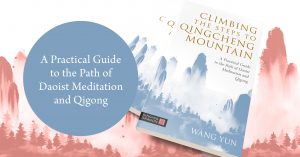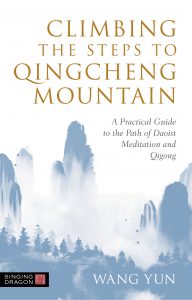 Mount Qingcheng, one of China’s mystical mountains, has been the birth place of discovery, realization and preservation of the recipes that stimulate the deep potential of the human body for generations. This is the book of a Daoist master and spiritual guide Wang Yun as a young seeker and tells the tales of his inner journey, which now guides the reader on a path of healing, rejuvenation and actualization of the body’s innate potential through Qigong and meditation.
Mount Qingcheng, one of China’s mystical mountains, has been the birth place of discovery, realization and preservation of the recipes that stimulate the deep potential of the human body for generations. This is the book of a Daoist master and spiritual guide Wang Yun as a young seeker and tells the tales of his inner journey, which now guides the reader on a path of healing, rejuvenation and actualization of the body’s innate potential through Qigong and meditation.
Climbing the Steps to Qingcheng Mountain brings Wang Yun’s knowledge and wisdom to the West for the first time – and below we have shared some simple Qigong exercises from the book that both beginners and experienced practitioners can try.
Backstepping Peacock
This exercise can strengthen less commonly used muscle groups, as well as aid in weight loss. The extension of the spine as instructed is also of general benefit to spinal health.
- Interlace the fingers with the exception of the middle fingers. The middle fingers should be fully extended and pressed together, and the hands clasped tightly.
- Raise your clasped hands over your head and straighten the arms, while also simultaneously bringing the heels off the ground until you are standing on the tips of your toes. Imagine an energy originating from the crown of your head and spreading upward. The whole body should now be in full extension.
- From this position, begin walking backward on the balls of your feet. Continue until you are short of breath, and rest. Try to increase the number of steps you can take with each session, doing so at a pace that is comfortable for you.
- You can get even better results if you practice this exercise on a slope or inclined surface.
Squatting Qigong
This Qigong is beneficial for improving curvature in the spine, bone spurs and other spine-related issues. It also improves the waist and kidney functioning and strength. This Qigong can be beneficial for both men and women.
- Begin with the legs wider than shoulder width and then place the spine and back close up to a wall. Relax your entire body, from the head down to the feet, and allow your breathing to be natural and even.
- Adjust your breath to the point of it becoming smooth and unhindered. After your entire body is relaxed, allow your body to slowly squat down. While squatting, make sure that your back and spine remain close up to the wall. During the squat, the feet need to be pointed out slightly in the shape of a “V.”
- Squat down until the buttocks and knees are at the same level, as if you are riding a horse.
- To finish, slowly raise yourself back up to the original position.
氣遍全身 – Qi Pian Quan Shen
This method of qigong is suitable to add at the end of another qigong practice. Its effects are most felt when you use it as such an ending practice.
 Climbing the Steps to Qingcheng Mountain
Climbing the Steps to Qingcheng Mountain
A Practical Guide to the Path of Daoist Meditation and Qigong
By Wang Yun
A first-hand story of mentorship and commitment to traditions of the past and the ability to use them in the present, this translation of a Daoist memoir offers a means of persevering in the deep cultivation of body and mind. Written in an authentic tone, the author weaves tales of his youth with practical exercises for health and healing.